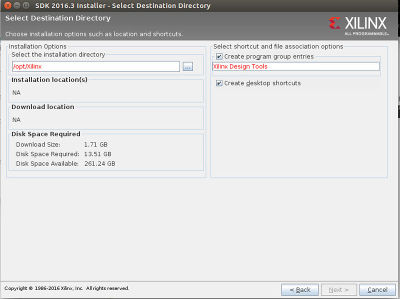Getting Started Guide for Xilinx Zynq Ultrascale+
|
|
Introduction
On this page, you are going to find all the necessary information for getting started with the Xilinx Zynq Ultrascale+ ZCU102 board.
Basic preliminary work
Setting up serial access to the Linux console
You can use termnet to control u-boot and Linux. For this purpose, the board needs to be connected to the same network as the host computer. This is useful because the board doesn't have to be directly connected to the PC containing the SDK.
If you use the serial port to control u-boot and Linux. The picocom terminal emulator works well for this purpose.
Setting up a TFTP server
If you are planning to use the SDK's installer to install images generated by the SDK in SPI-NOR, installing a TFTP server you will speed up downloads to the target hardware by using TFTP.
Setting up a NFS server
For application development, it is convenient to use the root NFS mount file system for the target hardware. This allows you to rebuild your application on the host and immediately run the application on the target hardware with no intervening steps. Your host PC needs to be configured as a NFS server for this in order to work properly.
Installing Toolchains and XSDK
Need to download Xilinx SDK XSDK for getting toolchain and image generator software. XSDK can be downloaded from:
Xilinx embedded designs tools downloads page
Select SDK 2016.3: Linux Self Extracting Web Installer You need to complete the Xilinx registration process in order to download. The file is around 1.3Gb
Change permissions to XSDK installer and execute:
cd ~/Downloads/ chmod 777 Xilinx_SDK_2016.3_1011_1_Lin64.bin ./Xilinx_SDK_2016.3_1011_1_Lin64.bin
Install XSDK 2016.3 at /opt/Xilinx/Downloads.
XSDK Install process images:
After installing a directory structure similar to the one shown below will be obtained:
ls /opt/Xilinx/SDK/2016.3 bin data doc eclipse gnu lib scripts settings64.csh settings64.sh tps
Xilinx Ultrascale+ File System
RidgeRun SDK is able to use different types of file systems:
- Basic file system created by Ridgerun SDK
- Ridgerun SDK is in charge of building basic applications to deploy this filesystem.
- This is a limited fs, but SDK has all Ridgerun classes to add more applications if needed.
- Very small footprint.
- File system with Busybox and Gstreamer.
- Basic Debian precompiled file system created by Ridgerun SDK (Still not available)
- Ridgerun provides a debian precompiled file system that is able to get packages with apt-get for aarch64
- Able to get applications from Debian repositories.
- Small footprint, allows the user to install packages as required
- Precompiled file system for ARM
- User just needs to indicate the path for the file system.
- Just available for Network File System (NFS).
- Any ARM file system can be used, but a precompiled and complete File System can be obtained from this link: Zynq UltraScale+ MPSoC Ubuntu part 2 - Building and Running the Ubuntu Desktop From Sources.
Instructions for using precompiled File System:
cd ~/Downloads unzip Ubuntu_Source_Release.zip chown $USER /opt/ mkdir /opt/ridgerun/downloads/ mkdir /opt/Xilinx/UbuntuFS cd /opt/Xilinx/UbuntuFS cpio -idv < ~/Downloads/Ubuntu_Source_Release/Linux_Files/rootfs_cpio/ZCU102_Ubuntu_2_rootfs.cpio
At the end you will obtain FS at the directory:
/opt/Xilinx/UbuntuFS$ ls @! dev home lost+found proc run sbin usr bin etc include media qt run_cube_del.sh srv var boot ffmpeg lib mnt QT_cube run_cube.sh sys cube_new glmark2.png log opt root run_desktop.sh tmp
See also
For direct inquiries, please refer to the contact information available on our Contact page. Alternatively, you may complete and submit the form provided at the same link. We will respond to your request at our earliest opportunity.
Links to RidgeRun Resources and RidgeRun Artificial Intelligence Solutions can be found in the footer below.








